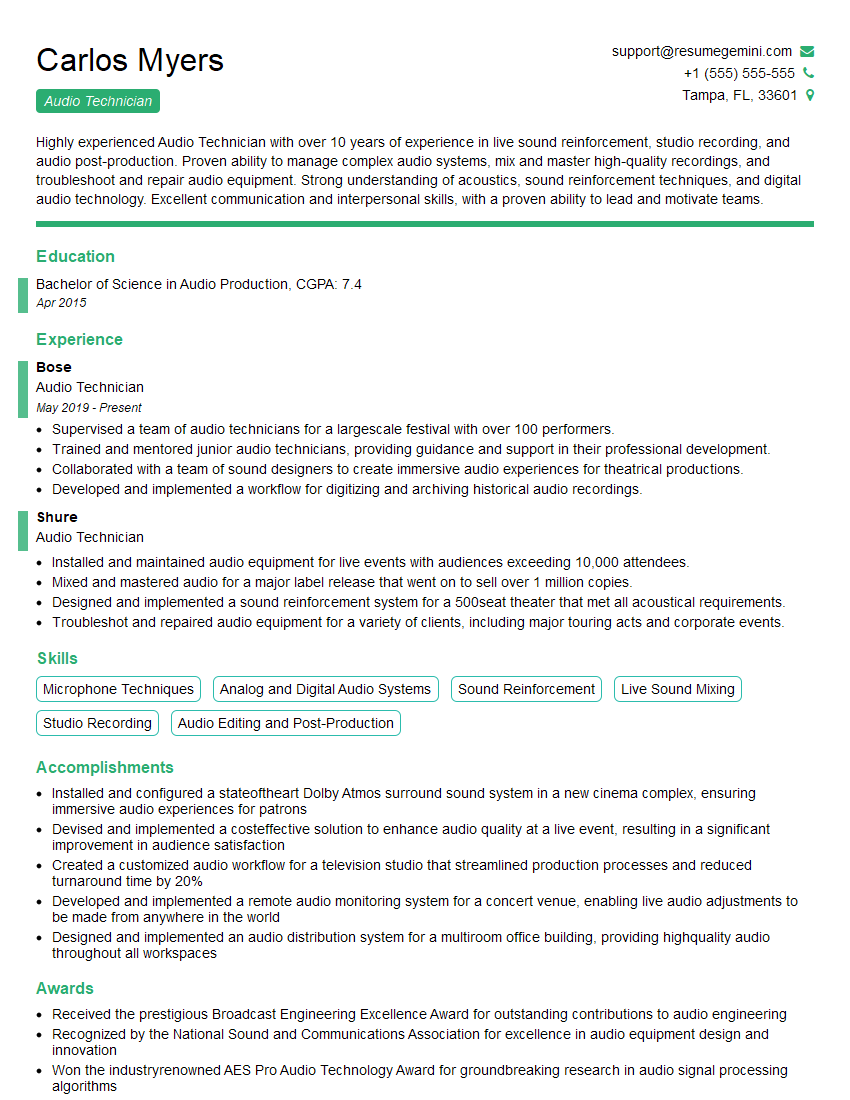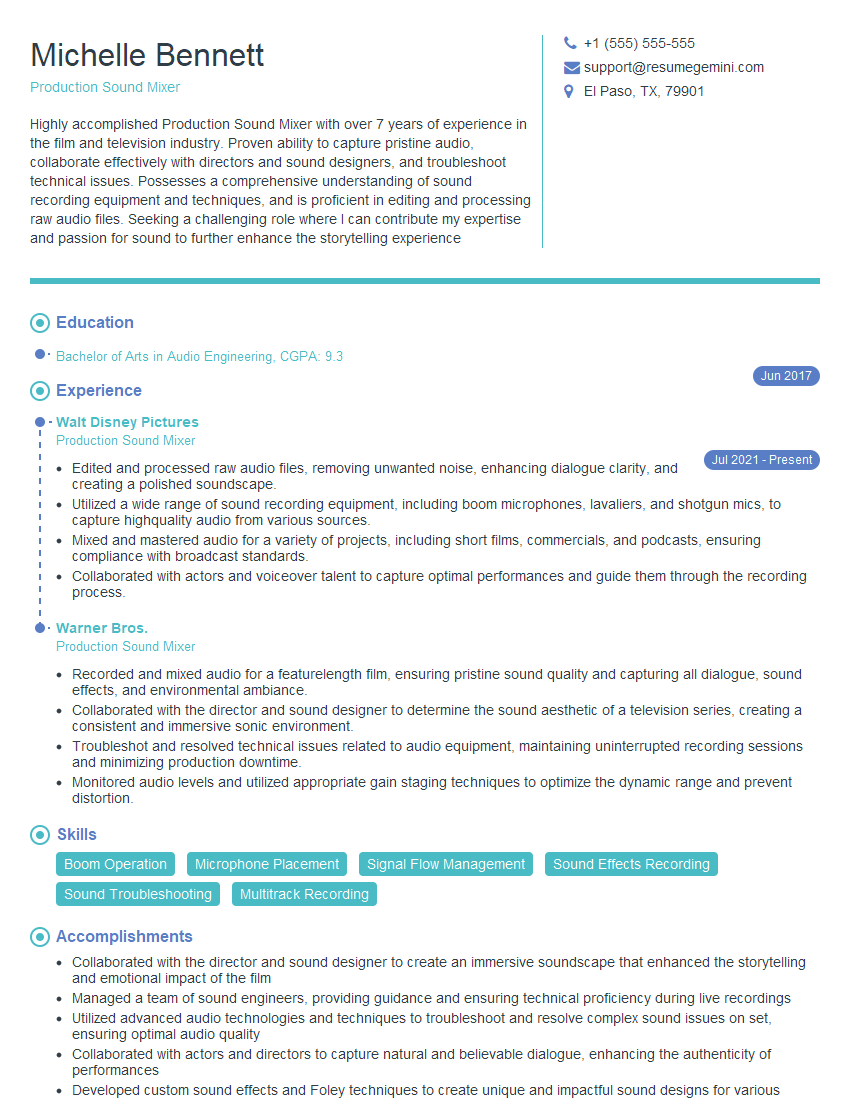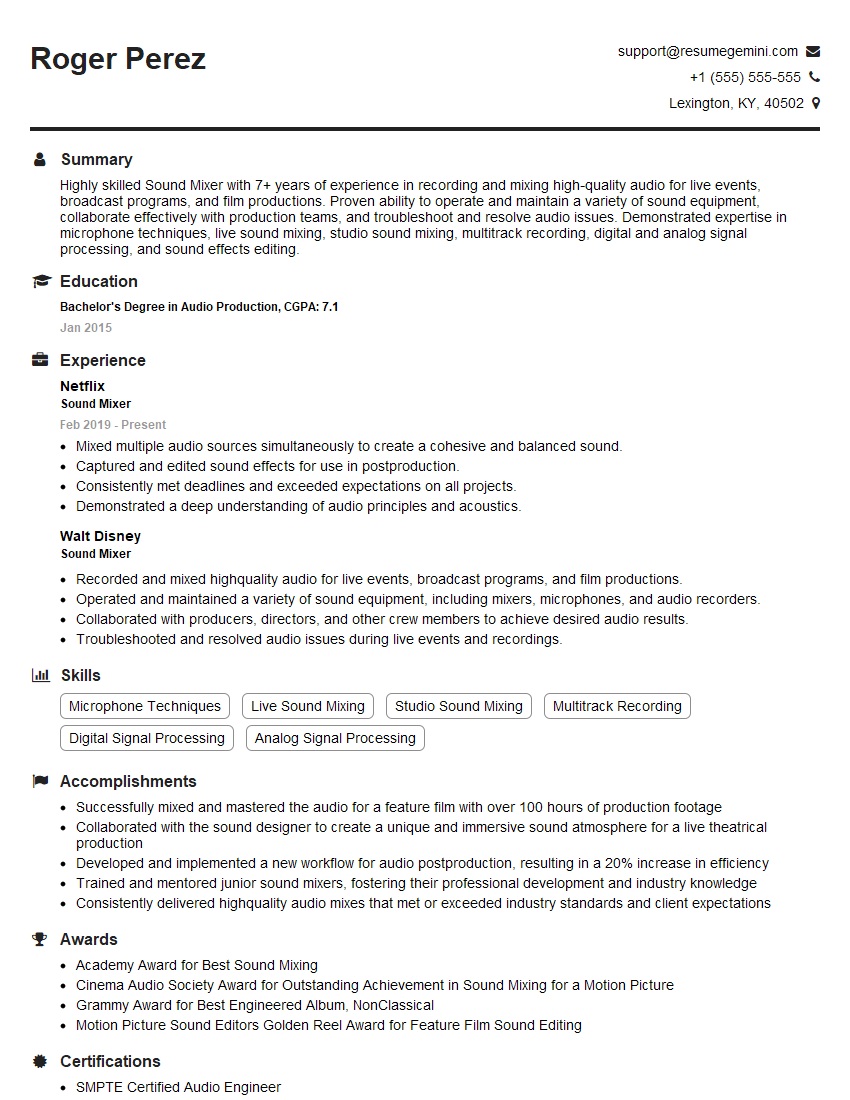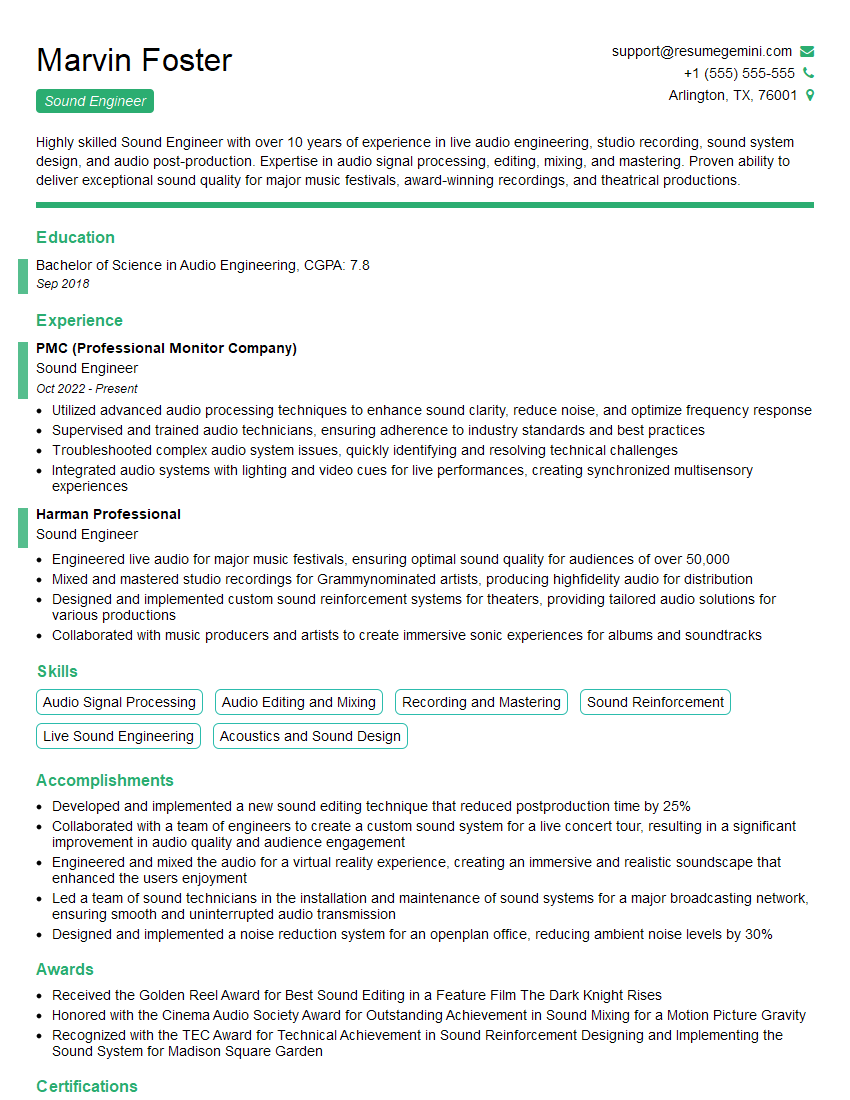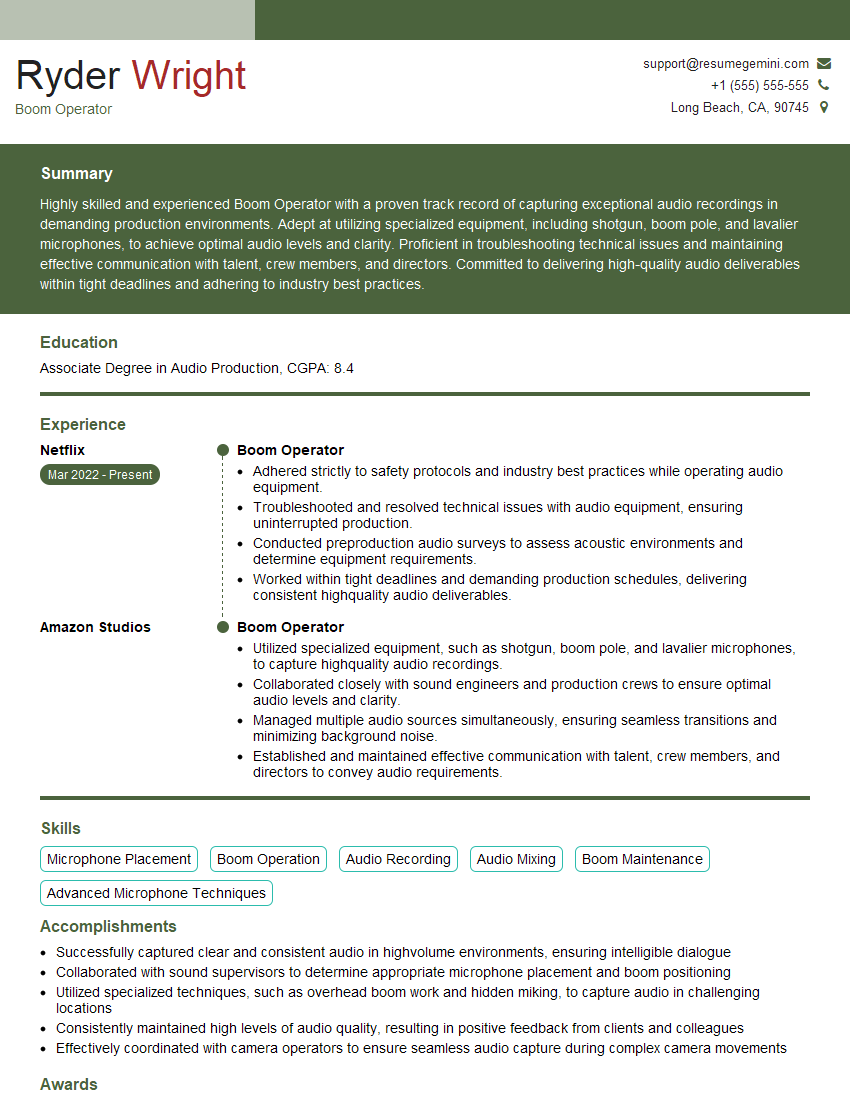The thought of an interview can be nerve-wracking, but the right preparation can make all the difference. Explore this comprehensive guide to Boom Operation interview questions and gain the confidence you need to showcase your abilities and secure the role.
Questions Asked in Boom Operation Interview
Q 1. Describe your experience with different types of boom poles.
My experience encompasses a wide range of boom poles, from lightweight carbon fiber models ideal for smaller productions and interviews to heavier, more robust poles designed for larger-scale film and television shoots. I’ve worked with both fixed-length and telescoping poles, each with its own advantages and disadvantages. For instance, fixed-length poles offer stability and predictable handling, while telescoping poles provide flexibility and reach. The choice depends entirely on the specific production demands and the environment. I’ve also used different types of mounting hardware, including shock mounts to minimize vibrations and various microphone clamps to ensure secure attachment.
- Lightweight Carbon Fiber: Excellent for handheld operation and portability, minimizing operator fatigue.
- Heavy-Duty Aluminum: Robust and durable, suitable for demanding environments and larger microphones.
- Telescoping Poles: Offer adjustable length, accommodating various shooting situations and distances.
Q 2. Explain the process of rigging a boom pole.
Rigging a boom pole involves a careful and methodical process to ensure safe and effective operation. It begins with selecting the appropriate pole and microphone based on the recording environment and desired sound quality. Next, I carefully attach the microphone to the pole’s clamp, making sure it’s secure and properly aligned. Then I use the correct shock mount to prevent vibrations from transferring to the microphone. The cable is then carefully connected, avoiding any kinks or twists which could introduce noise. Finally, I check the entire setup for any potential hazards before beginning the recording. This rigorous approach guarantees both audio quality and safety on set.
Think of it like setting up a fishing rod – each step is crucial to a successful catch (or in our case, high-quality audio!). A poorly rigged pole can result in noisy recordings and even potential equipment damage.
Q 3. How do you maintain a consistent sound level while booming?
Maintaining a consistent sound level while booming requires constant monitoring and subtle adjustments. I use a combination of techniques: I rely heavily on the audio meter on my recording device, keeping a close eye on the levels to prevent clipping or excessive low levels. I also continuously adjust the boom pole’s position relative to the sound source, ensuring the microphone remains at a consistent distance and angle. Experience plays a huge role; I’ve developed an intuition for how to anticipate changes in sound levels and make preemptive adjustments. Finally, I communicate closely with the sound recordist to ensure we’re achieving the desired audio quality throughout the entire shoot.
It’s almost like conducting an orchestra – you’re constantly making small adjustments to ensure everything sounds balanced and harmonious.
Q 4. What are the challenges of booming in different environments (e.g., wind, rain)?
Different environments present unique challenges. Wind, for example, is a significant factor, often requiring the use of windshields or blimps to minimize wind noise. Rain demands careful protection of the microphone and equipment, often necessitating the use of waterproof covers or working under shelter. In challenging environments, I adapt my technique, possibly using more robust equipment, employing noise-reducing techniques in post-production, or even rescheduling to a more favorable time.
- Wind: Windshields (deadcats), blimps, and careful mic placement are crucial.
- Rain: Waterproof covers, rain ponchos, and potentially relocating the recording location are necessary precautions.
- Outdoor Noise: Strategic mic placement, careful monitoring, and post-production noise reduction techniques are often essential.
Q 5. Describe your experience with wireless boom systems.
My experience with wireless boom systems has been overwhelmingly positive. They offer increased flexibility and mobility compared to wired systems, allowing for smoother camera movements and more creative shots. However, I’m keenly aware of the potential for interference and signal dropouts. I always check for potential interference sources and ensure the system is functioning correctly before commencing a shoot. Battery life is also a crucial factor, requiring careful planning and the availability of backup batteries.
Wireless systems are like a superpower – they grant freedom of movement but require careful management of potential risks.
Q 6. How do you manage cable management during a boom operation?
Cable management is paramount in boom operation. Tangled cables are a recipe for disaster, causing noise, trips, and potentially damaging equipment. I use cable ties, clips, and pouches to keep cables organized and out of harm’s way. I plan cable routes carefully, minimizing slack and avoiding crossing paths with other equipment or personnel. In addition to physical management, I’m meticulous in my labeling and identification of cables, ensuring quick and efficient setup and breakdown.
Efficient cable management is the unsung hero of a smooth and productive boom operation – a little forethought can prevent big problems.
Q 7. How do you ensure clear audio capture with a boom mic?
Ensuring clear audio capture with a boom mic involves a multifaceted approach. Proper microphone technique is fundamental; this includes selecting the right microphone for the job, understanding its polar pattern and frequency response, and positioning it appropriately in relation to the sound source. Minimizing background noise is also vital, often involving careful microphone placement, using appropriate wind protection, and controlling the environment. Finally, monitoring the audio levels throughout the recording process is crucial to ensuring a clean, high-quality recording. Regular calibration and maintenance of the equipment are also essential to avoid any technical issues impacting audio quality.
Think of it as sculpting sound – you carefully shape and refine the audio signal to extract the clearest possible recording.
Q 8. Explain your process for troubleshooting audio issues while booming.
Troubleshooting audio issues during booming requires a systematic approach. My process begins with identifying the problem’s source – is it a low signal, excessive noise, distortion, or something else? I then isolate the potential causes, which could range from microphone placement and cable issues to the microphone itself or the recording device’s settings.
For instance, if I encounter low signal, I’ll first check the microphone’s gain setting, ensuring it’s appropriately adjusted for the sound source’s volume. Next, I’ll inspect the cabling for any damage or loose connections. If the problem persists, I’ll check the input levels on the recorder and potentially test with a different microphone. High levels of background noise might indicate a problem with the environment (too many interfering sounds), the mic’s polar pattern (picking up unwanted sounds), or even wind noise. Then, I might need to adjust the boom’s position, use a windscreen, or employ noise-reduction techniques later in post-production. Distortion might signal clipping from a too-high gain setting, which I’d address by lowering gain and checking the recorder’s meters. My process involves careful observation, testing different variables, and systematic elimination of possibilities until the issue is resolved.
Q 9. What are some common boom operation techniques for dialogue recording?
Effective boom operation for dialogue recording hinges on a combination of techniques focused on capturing clean, clear audio while remaining unobtrusive. This involves understanding microphone polar patterns and their impact on sound pickup. For example, using a cardioid microphone effectively reduces background noise and ensures that the main sound source – the actor’s dialogue – is prioritized.
- Accurate Placement: This requires careful anticipation of actor movement and maintaining consistent distance and angle to the mouth. It’s like conducting an invisible orchestra, constantly adjusting the boom to follow the actor without becoming visible in the shot.
- Gentle Movements: Smooth, deliberate movements are crucial to avoid creating unwanted noise. Jerky motions can transmit vibrations through the boom pole to the microphone, resulting in unwanted noise.
- Maintaining Distance: Finding the optimal distance – often about a foot – balances sound quality with minimizing visibility. Too close and you risk proximity effect (bass boost); too far and you lose clarity.
- Understanding Room Acoustics: Being aware of reflective surfaces and how they might impact sound (e.g., echoes) allows me to position the boom to minimize these issues.
- Collaboration: Working closely with the director and camera operator is key. We need to coordinate movements and positions to ensure optimal audio capture without compromising the shot.
Q 10. Describe your experience with different types of microphones used in boom operation.
My experience encompasses a wide range of microphones used in boom operation, each suited for different contexts. I’ve extensively used cardioid condenser microphones like the Sennheiser MKH 416 and the Schoeps CMIT 5U, renowned for their clarity, sensitivity, and excellent rejection of off-axis sound. These are my go-to choices for dialogue. I’ve also worked with hypercardioid and supercardioid mics, which offer even greater rejection of unwanted sound, proving useful in noisy environments. In some situations, where a more compact and versatile setup is needed, I’ve utilized shotgun microphones, which balance portability with sufficient sound quality. The choice always depends on the specific demands of the production – whether it’s a large-scale film shoot, a smaller documentary, or an independent project. The characteristics of each mic – frequency response, sensitivity, polar pattern – inform my decision. Every mic has its nuances, and I’m comfortable adapting my technique to make the most of each.
Q 11. How do you work effectively with a sound mixer and other crew members?
Effective collaboration is the cornerstone of successful boom operation. My approach involves constant communication with the sound mixer, the camera operator, and the director. Before shooting begins, I discuss shot plans and anticipated movements with the director and camera operator, ensuring I understand the planned camera movements and actor positions, which greatly influence boom positioning. I regularly communicate with the sound mixer to ensure appropriate gain staging and monitor audio levels. We confirm that the microphone is properly connected and that all the signal levels are appropriate. This ongoing dialogue prevents problems before they arise. During filming, subtle gestures, or even a simple head nod, can signal adjustments or changes. Trust and open communication are vital for a seamless workflow.
Q 12. What is your understanding of microphone placement and its impact on audio quality?
Microphone placement is paramount in determining audio quality. It directly impacts proximity effect (bass boost at close distances), the amount of room sound captured, and the level of background noise picked up.
For example, placing a microphone too close to the sound source can lead to an excessive bass response – the proximity effect. Moving it slightly further away can significantly mitigate this. Conversely, positioning it too far away can result in the loss of detail and clarity. The microphone’s polar pattern also plays a crucial role; a cardioid mic, pointed directly at the source, will emphasize the direct sound while minimizing unwanted sounds from other directions. I constantly assess these factors, adjusting the microphone’s distance, angle, and height (often using a boom pole) to achieve optimal audio quality. I consider factors like room reflections, background noise sources, and the actor’s movement. It’s a dynamic process, demanding constant vigilance and adaptation.
Q 13. How do you handle unexpected situations on set that affect audio capture?
Unexpected situations are inevitable on set. My response depends on the nature of the problem. A sudden loud noise, like a car horn, can be mitigated by cutting the take immediately. If a plane flies overhead, a brief pause allows it to pass. If an actor unexpectedly moves out of the boom’s range, I’ll react quickly to reposition the boom. My training emphasizes quick thinking and adaptability. If there’s a significant issue (e.g., equipment failure), I collaborate with the sound mixer to find the quickest solution: a backup mic, an alternative audio capture method, or adjusting the take accordingly. Sometimes, reshoots are necessary. Documentation of these issues is critical – we meticulously note the problems encountered and the solutions implemented, which proves vital in post-production.
Q 14. How familiar are you with different audio recording formats and codecs?
I’m proficient in various audio recording formats and codecs commonly used in professional sound recording. This includes WAV (uncompressed, high-quality audio), which is my preferred choice for productions requiring the highest quality, and BWF (Broadcast Wave Format) which adds metadata crucial for post-production workflow. I’m also experienced with various compressed formats such as MP3 and AAC for situations where file size is a primary concern, although I understand the compromises these formats entail in terms of audio quality. I understand the advantages and disadvantages of different codecs regarding compression ratios, audio quality, and compatibility with post-production software. For example, I know that using a high-quality, lossless codec like WAV maintains the integrity of the audio signal, while a lossy codec like MP3 trades off some audio fidelity for smaller file sizes. The choice of format and codec always reflects the project’s requirements and prioritization between quality, file size, and compatibility.
Q 15. Explain your knowledge of audio signal flow.
Understanding audio signal flow is fundamental to boom operation. It’s the pathway an audio signal takes from its source (the actor’s voice) to the recording device. Think of it like a river flowing from its source to the sea.
The journey begins with the sound waves hitting the microphone’s diaphragm. This converts the acoustic energy into an electrical signal. This signal then travels through the microphone cable (the river’s channel) to the mixer (a control center managing multiple rivers).
The mixer processes the signal – adjusting levels, adding effects, etc. – before sending it to a recorder, which captures the signal digitally. Throughout this entire path, signal integrity is crucial; any interference or loss weakens the recording’s quality.
For example, a poor connection in the microphone cable can lead to a noisy signal, or improper gain staging on the mixer can result in clipping (distortion due to signal overload). Understanding the signal flow helps in troubleshooting issues and optimizing recording quality.
Career Expert Tips:
- Ace those interviews! Prepare effectively by reviewing the Top 50 Most Common Interview Questions on ResumeGemini.
- Navigate your job search with confidence! Explore a wide range of Career Tips on ResumeGemini. Learn about common challenges and recommendations to overcome them.
- Craft the perfect resume! Master the Art of Resume Writing with ResumeGemini’s guide. Showcase your unique qualifications and achievements effectively.
- Don’t miss out on holiday savings! Build your dream resume with ResumeGemini’s ATS optimized templates.
Q 16. How do you maintain the integrity and safety of the boom and microphone equipment?
Maintaining boom and microphone equipment integrity and safety is paramount. It’s not just about protecting the investment; it’s about ensuring a professional and safe working environment. I meticulously follow a multi-pronged approach:
- Pre-shoot inspection: Before every shoot, I thoroughly check the boom pole for cracks, loose connections, and proper functioning of any accessories. I also inspect the microphone for any damage, ensuring the capsule is clean and the windscreen is securely attached.
- Careful handling: I always treat the equipment with care, avoiding harsh movements or dropping the boom. When not in use, it’s stored in a protective case or bag.
- Regular maintenance: This includes cleaning the microphone and boom pole regularly, and checking cables for fraying or damage. I also regularly inspect shock mounts to ensure they’re functioning properly and providing sufficient isolation from vibrations.
- Safe working practices: I’m always aware of my surroundings, avoiding overhead obstructions, and ensuring the boom doesn’t interfere with other crew members or equipment.
- Environmental protection: I use protective covers for the microphone when not in use, especially outdoors, to shield it from dust, moisture, and other environmental hazards.
By adhering to these practices, I guarantee that the equipment remains in optimal condition and poses no safety hazards.
Q 17. Describe your experience with various boom pole accessories.
My experience with boom pole accessories is extensive. I’m proficient with various types, each serving a specific purpose:
- Shock Mounts: Essential for isolating the microphone from vibrations, especially during handheld shots or in noisy environments. I’ve used both Rycote Lyre and standard elastic shock mounts, understanding their strengths and limitations.
- Windscreen (deadcat): I’ve worked with various sizes and types of windscreens, adapting the choice to the environmental conditions. A fluffy deadcat is invaluable in windy conditions.
- Blimps: For situations demanding maximum isolation from wind noise, I’ve used blimps with integrated shock mounts and windshields. These are more complex, and I know how to correctly balance and operate them.
- Microphone clamps/holders: I can efficiently and securely attach various types of microphones to different boom poles and adaptors.
- Extension poles: I have experience using extension poles to reach challenging areas while maintaining control and stability.
My selection of accessories always depends on the specific needs of the project, taking into account factors like environment, microphone type, and camera movement.
Q 18. How do you adapt your booming techniques for different camera movements?
Adapting booming techniques to different camera movements requires anticipation and precision. It’s a dance between the camera and the microphone.
Static Shots: Relatively straightforward; I position the boom carefully to capture clean audio. The key is maintaining consistent distance and avoiding sudden movements.
Tracking Shots: These demand smooth, fluid movements of the boom pole to maintain audio quality as the camera moves. I anticipate the camera’s path and move accordingly, ensuring the microphone remains appropriately positioned.
Crane Shots: These require careful coordination with the crane operator, anticipating changes in elevation and distance. I communicate constantly to ensure the microphone maintains a clear audio path, avoiding sudden jarring movements.
Steadicam Shots: These require particularly delicate booming as the camera’s movement is highly fluid and unpredictable. I must anticipate the camera operator’s moves and remain agile and responsive.
In all cases, maintaining a consistent distance between the microphone and the sound source is key. This ensures consistent audio levels and minimizes background noise.
Q 19. What are some safety precautions you take when working with a boom pole?
Safety is always my top priority when working with a boom pole. I consistently follow these precautions:
- Awareness of surroundings: I constantly scan my environment, being aware of overhead obstructions, power lines, and other crew members.
- Proper grip: I use a secure and comfortable grip on the boom pole to prevent accidental drops or swings.
- Controlled movements: I make smooth, deliberate movements, avoiding sudden jerks that could cause accidents or damage equipment.
- Communication: I maintain clear communication with the camera operator, other crew members, and the talent to ensure everyone’s safety and awareness of the boom’s position.
- Avoiding obstacles: I carefully navigate around obstacles, ensuring the boom pole doesn’t hit anything or anyone.
- Correct weight distribution: I ensure the boom pole is balanced correctly to avoid strain and fatigue, leading to potential accidents.
Ultimately, a safe work environment is a productive one, and proactive safety measures prevent accidents and delays.
Q 20. How do you handle difficult or challenging dialogue recording situations?
Difficult dialogue recording situations require creative problem-solving and adaptability. For instance, recording dialogue in a noisy environment might necessitate employing techniques like:
- Using directional microphones: This helps focus on the sound source while minimizing unwanted background noise.
- Employing a blimp and/or shotgun microphone: Blimps significantly reduce wind and handling noise, while a shotgun microphone focuses on the subject’s sound.
- Post-production cleanup: While not ideal, sound design techniques in post-production can help mitigate some issues. Noise reduction software can greatly assist in reducing background noise that may have been captured.
- Microphone placement techniques: This includes experimenting with different distances and angles to optimize sound capture.
- Communication and cooperation: Working closely with the director and actors to manage the environment or create moments of silence between lines greatly helps in acquiring clean audio.
Every challenging situation requires a unique solution; I tailor my approach using experience, creativity, and a systematic problem-solving process.
Q 21. Explain your process for prepping and checking equipment before a shoot.
My equipment prep and check process is thorough and systematic, ensuring a smooth and successful shoot. It usually looks like this:
- Visual inspection: I thoroughly examine all equipment (boom pole, microphone, cables, accessories) for any physical damage or wear and tear.
- Functional testing: I test the microphone’s functionality, ensuring it’s picking up sound correctly. I also test the cables and connections, checking for any signal loss or interference.
- Gain staging and sound check: I check and adjust the microphone’s gain on the mixer, ensuring proper levels without clipping. I perform a test recording to assess audio quality.
- Battery check: I ensure all batteries are fully charged, noting the backup batteries, and if applicable, check the power supply for the recording equipment.
- Accessory verification: I double-check that all necessary accessories are ready and properly attached (shock mount, windscreen, cable ties, etc.).
- Backup equipment preparation: I always have backup equipment ready in case of failure – extra microphones, cables, batteries, and a portable recorder.
This meticulous approach ensures that any potential problems are identified and addressed before shooting begins, resulting in fewer delays and a high-quality end product.
Q 22. Describe your experience with various boom mic techniques for different scenes.
Boom mic techniques vary drastically depending on the scene’s demands. For intimate scenes with close-ups, I favor a ‘tight boom’ technique, positioning the mic as close as possible to the talent while remaining invisible. This prioritizes clear audio and minimizes background noise. Conversely, wide shots often require a ‘long boom’ approach, where the mic is further away and might necessitate using a longer boom pole to capture dialogue from multiple actors across a larger space. In action scenes, I prioritize quick, responsive boom operation to keep up with the movement. This might involve using a smaller, lighter boom for agility, or employing a second boom operator for redundant coverage. I also adjust my technique based on the acoustics of the environment. A highly reverberant space may require more careful mic placement to avoid unwanted reflections. For instance, in a large cathedral, I would likely utilize a tighter boom and employ additional sound treatment techniques like gobo placement to control the reverberation.
Consider a scene with two actors – one seated, one standing. For the seated actor’s close-up, a tight boom is essential. But when both are in the frame, a longer boom becomes necessary, requiring precise positioning to capture both voices clearly without being visible. The key is adaptability; the best technique isn’t fixed but rather context-dependent.
Q 23. How familiar are you with different types of sound recording equipment?
My experience encompasses a broad range of sound recording equipment, including various types of condenser microphones (e.g., Schoeps, Neumann, Sennheiser), dynamic microphones (like the Sennheiser MD 421), and various boom poles (lightweight carbon fiber for agility, heavier duty poles for stability). I am also proficient with digital audio recorders (Sound Devices, Zoom), wireless microphones (Sennheiser, Lectrosonics), and audio mixers (Sound Devices, Yamaha).
Understanding the nuances of each piece of equipment – its frequency response, sensitivity, and potential limitations – is crucial. For example, while a Schoeps CMC641 is excellent for its clarity and detail, it may not be ideal for high-noise environments. In such cases, a more robust dynamic microphone might be preferred. I always select the equipment based on the specific needs of the scene and location.
Q 24. Explain your knowledge of sound field recording techniques.
Sound field recording aims to capture the entire acoustic environment surrounding the sound source. This is often achieved by using multiple microphones arranged strategically to capture the spatial characteristics of the sound. Techniques include using an Ambisonics microphone array for immersive spatial audio capture, or deploying a more traditional stereo recording setup with spaced pair or coincident microphone configurations. I’ve used various methods depending on the specific requirement. For instance, using an ORTF microphone configuration (two cardioid mics at a specific angle) is perfect for dialogue recording as it’s natural-sounding and provides a good balance between stereo width and imaging. My experience also includes the use of dummy heads and binaural microphones for exceptionally realistic recordings. The choice of technique significantly impacts the immersive quality of the final audio.
Consider recording a bustling city street. A spaced pair stereo technique might be ideal to capture the general ambience, while more directional mics would focus on a specific conversation, enabling detailed separation of sound sources in post-production.
Q 25. How do you ensure the boom is out of frame during filming?
Keeping the boom out of frame requires a combination of skill, communication, and awareness. Firstly, I maintain constant visual contact with the camera’s viewfinder (or monitor) throughout the entire scene. Second, close collaboration with the camera operator is essential – we constantly communicate to coordinate camera movements and boom positioning. This often involves anticipating camera movements and adjusting the boom’s position proactively. Finally, I use techniques like concealment (keeping the boom behind objects) and careful angling to keep the boom out of the camera’s line of sight.
Imagine a scene where the camera is panning across a wide shot. Anticipating the pan’s direction, I subtly adjust the boom to remain consistently outside the frame. This requires careful coordination and experience, avoiding abrupt movements that may be noticeable.
Q 26. Describe your experience with different ambient noise reduction techniques.
Ambient noise reduction is crucial for achieving high-quality audio, particularly in locations with unwanted sounds. My techniques incorporate both on-set mitigation and post-production processing. On-set strategies include strategic microphone placement to minimize noise pickup and utilizing absorbent materials (like gobos or blankets) to dampen unwanted reflections. In post-production, I use noise reduction software (like RX or Izotope) to further refine the audio. This can involve spectral editing to remove specific frequency bands containing noise, or using de-noising algorithms that intelligently differentiate between noise and the desired audio. The key is to achieve noise reduction without compromising the audio’s natural quality or clarity.
For example, if recording outdoors near a busy road, I’d use a combination of strategic mic placement (placing it between the talent and the noise source if possible), potentially employing a wind screen, and post-production noise reduction tools to mitigate the road traffic noise.
Q 27. What is your understanding of gain staging and its importance in boom operation?
Gain staging is the process of setting the appropriate input gain levels throughout the audio chain, from the microphone to the recorder. It’s vital for boom operation to prevent clipping (audio distortion from exceeding the maximum signal level) and maximize the signal-to-noise ratio (SNR). A poorly managed gain stage results in weak audio susceptible to noise, or worse, clipped audio. In practice, I start by setting the microphone gain level appropriately, ensuring it’s high enough to capture the desired signal cleanly but low enough to avoid clipping. I then manage the gain levels on any audio interfaces or recorders.
A good analogy is a camera’s exposure. Just as correct exposure prevents overexposed or underexposed images, proper gain staging prevents excessively loud or quiet audio. Accurate gain staging is foundational to achieving clean, professional-quality audio.
Q 28. Describe your experience working in both indoor and outdoor sound recording environments.
My experience spans a wide range of indoor and outdoor environments. Indoor recording requires careful attention to room acoustics – identifying and mitigating issues like echo or reverberation. Techniques include strategic microphone placement, using gobos to dampen reflections, or potentially employing additional sound treatment. Outdoor recordings present their own set of challenges, such as unpredictable wind noise, environmental noises (traffic, birds), and varying acoustic properties.
For example, recording in a live music venue demands a different approach than recording a quiet conversation in a library. In a venue, I might utilize multiple microphones and employ signal processing to manage feedback. While the library recording necessitates a much more sensitive approach to capture subtle details while actively minimizing ambient noise.
Key Topics to Learn for Boom Operation Interview
- Boom Operation Fundamentals: Understand the core principles and lifecycle of a typical boom operation, including planning, execution, and post-operation analysis.
- Safety Procedures and Regulations: Demonstrate knowledge of relevant safety protocols, risk assessment methodologies, and compliance with industry regulations related to boom operations.
- Equipment Operation and Maintenance: Familiarize yourself with the various types of boom equipment, their operational capabilities, and routine maintenance procedures. Be prepared to discuss troubleshooting common issues.
- Logistics and Coordination: Explain your understanding of the logistical aspects involved in boom operations, including resource allocation, scheduling, and coordination with other teams or stakeholders.
- Data Analysis and Reporting: Discuss your experience with collecting, analyzing, and interpreting data related to boom operation efficiency, safety performance, and cost effectiveness. Be prepared to present findings and make recommendations.
- Problem-Solving and Decision-Making: Showcase your ability to identify and solve problems under pressure, make sound judgments in challenging situations, and adapt to unexpected circumstances during a boom operation.
- Teamwork and Communication: Highlight your skills in effective teamwork, communication, and collaboration with diverse teams within a boom operation environment.
Next Steps
Mastering Boom Operation principles opens doors to exciting career opportunities with significant growth potential. To maximize your job prospects, creating a strong, ATS-friendly resume is crucial. ResumeGemini is a trusted resource that can help you build a professional and impactful resume tailored to highlight your skills and experience in Boom Operation. Examples of resumes tailored to this field are available to help guide you.
Explore more articles
Users Rating of Our Blogs
Share Your Experience
We value your feedback! Please rate our content and share your thoughts (optional).
What Readers Say About Our Blog
Hi, I’m Jay, we have a few potential clients that are interested in your services, thought you might be a good fit. I’d love to talk about the details, when do you have time to talk?
Best,
Jay
Founder | CEO
